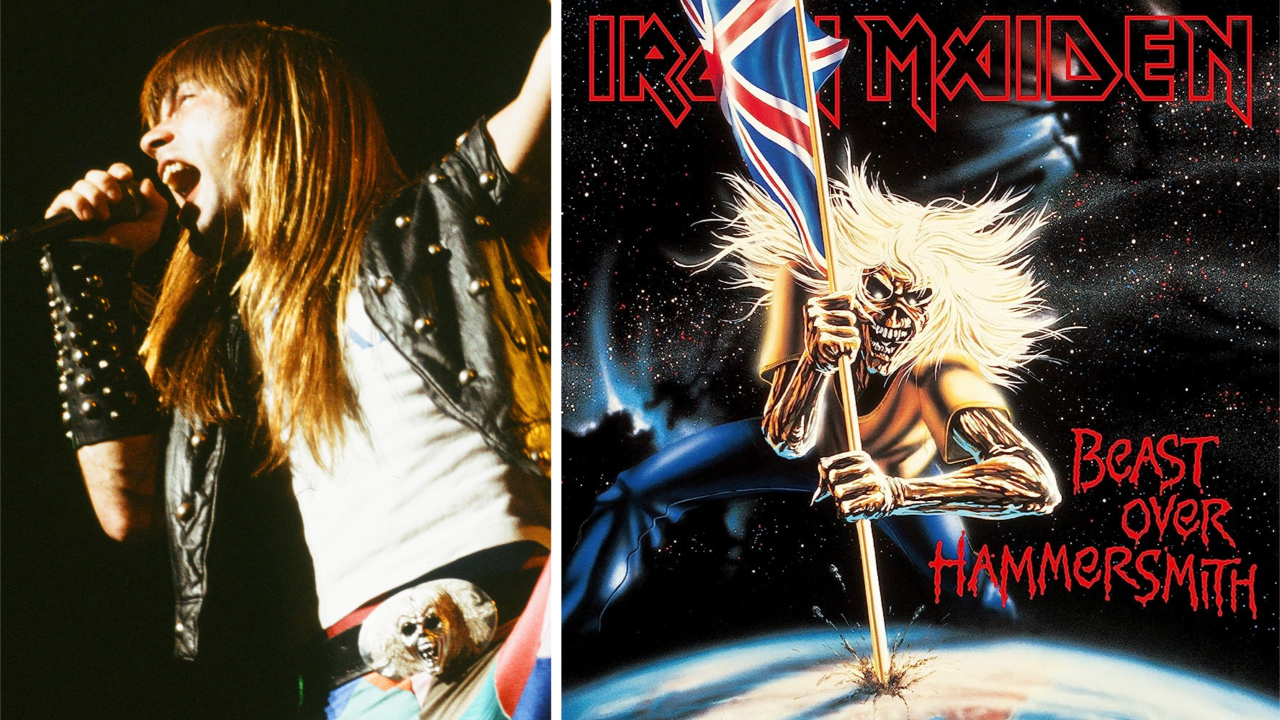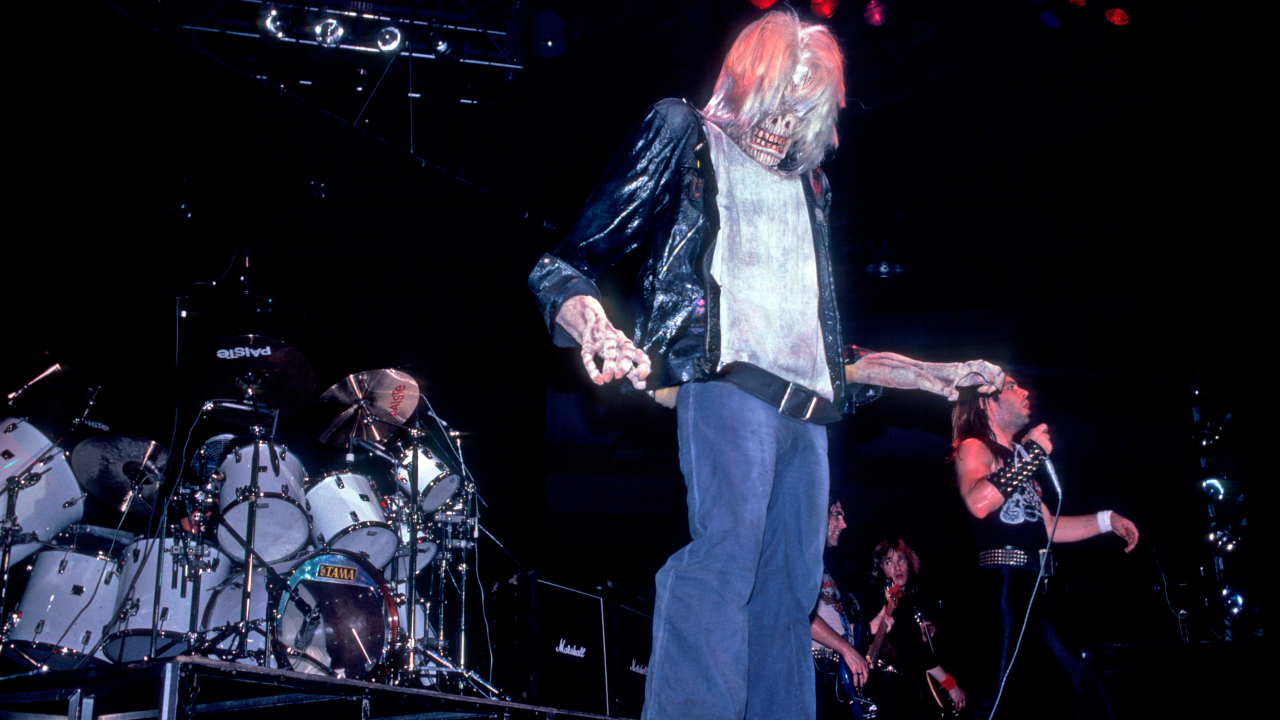
Heavy metal historians will always associate the live album with Iron Maiden. Not only are Eddie and the boys responsible for a paragon of the format in Live After Death, but they’re apparently dedicated to immortalising as many of their own shows as possible. Maiden England, Rock In Rio, Flight 666, En Vivo! – all of them have reaffirmed this band’s drive to broadcast their performances across an entire global fanbase.
The Beast’s reputation for live recordings makes it all the more stunning when you learn that, for 20 years, they kept one of their finest locked in a vault. Beast Over Hammersmith could have been a breakout live album three years before Live After Death announced Maiden’s on-stage excellence to anyone who’d never bought a ticket. Captured on March 20, 1982 (two days before The Number Of The Beast came out) at the Hammersmith Odeon, it shows a band in majestic form at the height of their relevance. So why was it shelved for so long?
“When we originally did it, the people who videoed it were supposed to do their homework by coming to two shows before Hammersmith,” bassist Steve Harris explained in a 1987 interview. “And they didn’t. Consequently, the lights ended up being too dark. So, basically, there was no way we were gonna put out the full hour-and-a-half video, because it would have been a rip-off.”
The people who videoed it were supposed to do their homework. They didn’t.
Steve Harris
To this day, the full concert film has never been released to the public. There’s a 46-minute cut on YouTube, but that’s the most you’ll see. The audio, meanwhile, has come out – first as a CD in the 2002 Eddie’s Archive box set, then finally on vinyl another two decades later.
The delays and half-release sting, since both sonically and symbolically, Beast Over Hammersmith is special. It’s the sound of Maiden caught inside a whirlwind of mainstream intrigue. Run To The Hills charged to number seven in the UK charts the week before the show while, in the States, the band were conservatives’ greatest nemesis during the satanic panic.
“We were due to go on a TV show once,” guitarist Adrian Smith remembered in the 2005 documentary The History Of Iron Maiden: Part One. “The presenter looked at the album cover, and we watched in the wings as she recoiled in horror. They chucked us out! People were reacting.”
“It gave us loads of publicity,” added frontman Bruce Dickinson. “The kids who did wanna buy our records were like, ‘Oh cool! The religious right are burning their records! I better buy half a dozen!’”
That momentum practically becomes audible when the album opens with the band sprinting onto their stage. Bruce snatches his mic during a thunderous Clive Burr drum roll and immediately snarls his way through Murders In The Rue Morgue. His confidence and vocal power belie the fact that he was on just his first full tour with Maiden.
Run To The Hills rears its head surprisingly early and is met with adulation by a crowd who’d only had a few weeks to learn the words. Later, Hallowed Be Thy Name and The Phantom Of The Opera hit a bombastic one-two punch, telegraphing the importance of progressive suites to the “new” Maiden. Then Drifter, Running Free and Prowler wrap up: a send-off to the down-and-dirty punk stylings that essentially left the band with ex-singer Paul Di’Anno the year prior.
Beast Over Hammersmith captures more than just a transition between vocalists, too. The show came just weeks into the soon-to-be monolithic Beast On The Road jaunt – so early on that the album Maiden were promoting wasn’t even out yet. It was a tour that saw the band’s imagery vastly evolve, debuting an eight-foot-tall Eddie and backing dancers dressed as demons, both of which appear during a vigorous Iron Maiden.
Beast On The Road would also go on to be the first truly stacked run of Maiden’s career: 180 shows in 10 months. It marked the start of a battle for road warrior status that climaxed with the infamously extensive World Slavery trek, which journeyed five continents in 331 days.

“I remember, on Number Of The Beast, we did the Colosseum in El Paso [Texas],” Bill Barclay, guitarist Dave Murray’s former tech, said in The History Of Iron Maiden: Part One. “Then we flew to England, did Reading Festival, and the next show was Long Beach, California – within a few days. It was heavy going.”
Sadly, Clive wouldn’t finish the trek. The late drummer parted with Maiden during the Beast On The Road tour, with explanations as to why conflicting, ranging from him leaving to mourn his father to him struggling with the wild schedules and partying. Regardless of the reason, the exit makes Beast Over Hammersmith an epitaph to Clive, who sounds particularly primal. He’s audibly pummelling his kit during the choruses and escalating bridge of Children Of The Damned, then his fills between the start-stop guitar chords of The Prisoner make the song the heaviest it’s ever been.
Beast Over Hammersmith could have been the first great Maiden live album. Its audio rivals Live After Death in its prowess and power, and the video would have documented the band’s first ascent to unabashed theatre. As it stands, it’s an artefact only half-remaining, but it’s still deserving of so much more recognition.







